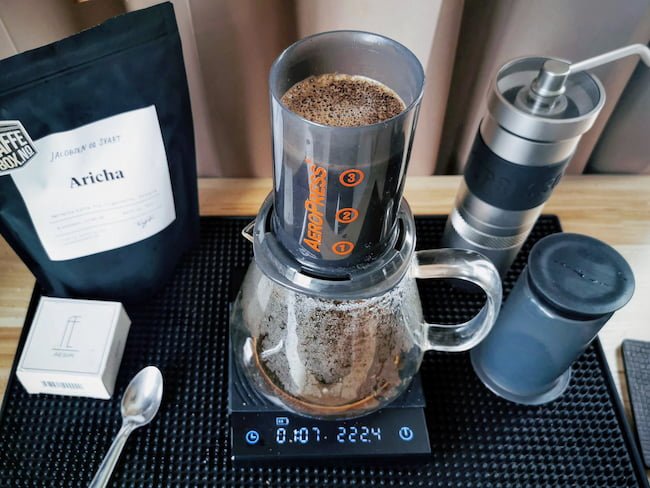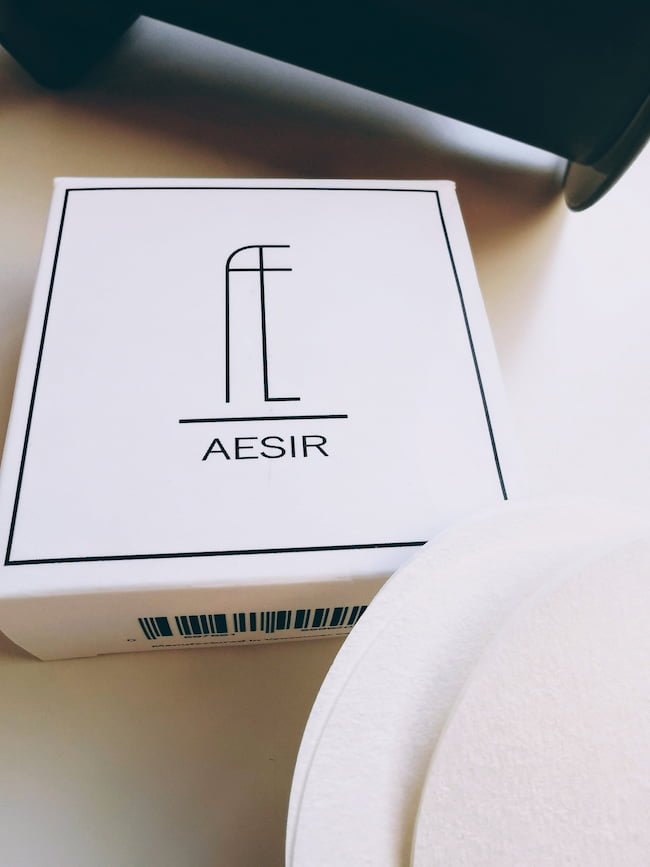When it comes to pour over coffee, we acknowledge how big a role different kinds of filters can play.
Not just when it comes to the material, but even down to the type of paper and pulp that is used.
In the realm of AeroPress, we’re starting to get to the same level of detail.
Here’s a quick guide to the difference between 4 popular types of AeroPress filters. There is much more to filters than just using Aerobie’s cheap, mass-produced ones. Find out what my favorite filter is in this article.

Regular AeroPress Filters
You probably already know and have used the regular AeroPress filters, so I won’t spend too much time on them in this post.
There are a couple of good things to say about them, though:
- They are cheap
- Widely available
- It will do an okay job if you use two (yes, 2!) at the same time
However, the standard filters often produce a slightly muddy cup if you ask me. This is called “turbidity” by scientifically inclined coffee geeks.
Turbidity refers to the cloudiness or haziness in a liquid caused by suspended particles or impurities. In coffee, it’s often caused by tiny coffee grounds, oils, and other compounds that make their way into the final brew because the filter material has too large pores or pressure has been involved..
The flavor effect can be significant. Higher turbidity typically results in a heavier, more full-bodied coffee. This can be desirable for some coffee drinkers, particularly those who enjoy darker roasts or more robust flavors.
However, turbidity can also mask some of the more delicate and nuanced flavors in coffee, particularly those found in lighter roasts or beans with fruity or floral notes.
It’s for those reasons that I much prefer the next filters on this list, which significantly reduce turbidity.
Aesir AEROPRESS filters

When it comes to pour over drippers, it’s well-known that the different paper filters significantly impact the final flavor of the brew.
With the Aeropress, we haven’t given much thought to the paper filters until recently.
The introduction of ‘Aesir’ filters has revolutionized the AeroPress brewing experience by significantly reducing turbidity. These filters, while having the same diameter as traditional Aerobie paper filters, are considerably thicker and denser.
Aesir filters are made from a new type of paper, which comes from a more dense and consistent pulp than what you’d find in most coffee filters.
This means the filters have tiny pore sizes, keeping those pesky sediments and itty-bitty particles from sneaking into your final cup.
Now, you might think regular AeroPress filters do the same thing, but when you add around 1.5 bars of pressure, they become more porous. That means they let some of those bitter compounds seep into your cup, making the coffee taste not as great as it could.
I was a bit skeptical when I first tried Aesir filters, but I was sold after that first brew. The coffee’s clarity and taste were seriously impressive.
If you want a ‘cleaner’ and more transparent cup profile similar to pour over rather than AeroPress, I highly recommend that you try these filters.
My personal opinion is that out of any single AeroPress hack or technique, you can think of, using Aesir filters may have the most significant impact.
A long list of national and international champions have used Aesir filters during the last couple of years.
Prismo Filter Cap

The Prismo filter cap was developed to improve the espresso capabilities of the AeroPress.
Unfortunately, in reality, it didn’t succeed. The valve in the Prismo is just too easy to activate, so you don’t produce a high amount of bars before liquid starts flowing.
However, the good thing about the Prismo is that it can restrict flow during the steeping phase. Therefore, when using it, you will not have any bypass or premature dripping.
For instance, if you want a 5-minute steep before plunging, you can swiftly achieve that with the Prismo.
Of course, there are also techniques like brewing upside-down or using an airlock by lifting the plunger slightly, but both methods have downsides.
I don’t hold the Prismo in high regard, but some coffee geeks swear by it, so it’s worth figuring out which camp you’re in.
By the way; the Prismo can be used with or without a paper filter – depending on your preference.
AEROPRESS FLOW CONTROL FILTER CAP
New to the AeroPress filter scene is the AeroPress Flow Control Filter Cap made by Aerobie themselves. This is one of the first new products released from Aerobie after the company was acquired by a new owner
💡 Sidenote: Alan Adler was always very conservative when it came to releasing new products, but the new owners have already announced a range of new gadgets to be released soon
While I haven’t had the chance to try the Flow Control Filter Cap myself yet, I’ve been looking into the product description and user feedback to give you an idea of what to expect from this new accessory.
According to the company, the Flow Control Filter Cap is designed to elevate your coffee brewing game by using a pressure-actuated valve to eliminate drip-through and maximize control over the brewing process.
However, a more realistic description of the product is that it is AeroPress’ own version of what the Prismo is doing.
The Flow Control filter cap fits perfectly on both Go and the regular AeroPress. And it can be used with metal and paper filters, together or separately, for maximum brew versatility.
The cap promises espresso-like crema if you use finely ground coffee, but you can also experiment with coarser-ground coffee and use long steeping times, similar as to what many coffee geeks do with the Prismo.
I have seen some users compare the Flow Control Filter Cap favorably to the Prismo. Allegedly, it’s more suitable for use in conjunction with paper filters, offers better sealing, and compatibility with smaller cups. The nozzle design prevents choking and clogging, allowing for a more convincing espresso-like drink.
The user also noted that it was easier to grip and remove from the AeroPress than the Prismo.
Based on this feedback, it seems that the Flow Control Filter Cap could be a worthy addition to your AeroPress setup. Once I get my hands on it, I’ll provide a comprehensive review to help you decide if it’s the right choice for your brewing needs.
Metal Filter Disc
The AeroPress metal filter disc is perhaps the oldest AeroPress hack there is.
Today, there are countless different versions available online.
Essentially, they all do the same, letting more oils through to the cup than the paper filters.
They also have another advantage, since they are reusable.
Many old-school coffee drinkers like the kind of mouthfeel you get from metal-filtered coffee. More oils in the cup also mean a thicker mouthfeel. If you’re using a medium or dark roast, that might be a desirable feature.
Personally, I favor clarity (so that means paper filtration), but if you like something else, then by all means go ahead.
There are a few different brands out there. Some have a bit more pedigree, for instance, Able and Cafe Concetto.
And recently, AeroPress actually released their own “official” version of a metal disk filter.
There will also be some variations in how fine the mesh is. Smaller holes will naturally do a better job of filtering the brew.
If you want to experiment, you can get a set like this one with both fine and superfine filters.
FAQ
The number of times you can reuse Aeropress filters depends on a few factors, including how well you clean them. Generally speaking, you should be able to get 3-5 uses out of a filter before it starts to affect the taste of your coffee. However, if you’re a real coffee aficionado, you may want to change your filter more frequently in order to enjoy the cleanest flavor of your brew.
You can buy a range of 3rd party products and use instead of the original AeroPress filters. Click on this article, for a wide range of suggestions! With a bit of patience, you can also cut out filters from your regular cone-shaped coffee filters.
Yes, generally speaking, AeroPress filters are the same size (2.5 inches or 6.35 cm). The filter must create a proper seal around the edges of the cap. For this reason, you cannot use a filter that is either too small or large.
That being said, I have previously used a 6 cm moka pot paper filter on a few occasions, even though they are a bit too small. It can work, just be careful when you place the filter and plunge the brewer.


